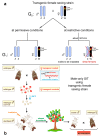Advances and Challenges of Using the Sterile Insect Technique for the Management of Pest Lepidoptera
- PMID: 31731445
- PMCID: PMC6921062
- DOI: 10.3390/insects10110371
Advances and Challenges of Using the Sterile Insect Technique for the Management of Pest Lepidoptera
Abstract
Over the past 30 years, the sterile insect technique (SIT) has become a regular component of area-wide integrated pest management (AW-IPM) programs against several major agricultural pests and vectors of severe diseases. The SIT-based programs have been especially successful against dipteran pests. However, the SIT applicability for controlling lepidopteran pests has been challenging, mainly due to their high resistance to the ionizing radiation that is used to induce sterility. Nevertheless, the results of extensive research and currently operating SIT programs show that most problems with the implementation of SIT against pest Lepidoptera have been successfully resolved. Here, we summarize the cytogenetic peculiarities of Lepidoptera that should be considered in the development and application of SIT for a particular pest species. We also discuss the high resistance of Lepidoptera to ionizing radiation, and present the principle of derived technology based on inherited sterility (IS). Furthermore, we present successful SIT/IS applications against five major lepidopteran pests, and summarize the results of research on the quality control of reared and released insects, which is of great importance for their field performance. In the light of new research findings, we also discuss options for the development of genetic sexing strains, which is a challenge to further improve the applicability of SIT/IS against selected lepidopteran pests.
Keywords: SIT; cytogenetics; genetic sexing; inherited sterility; moths; pest control programs; quality control.
Conflict of interest statement
The authors declare no conflict of interest. The funders had no role in the design of the study, in the interpretation of data, in the writing of the manuscript, or in the decision to publish this review.
Figures









References
-
- Klassen W. Area-wide integrated pest management and the sterile insect technique. In: Dyck V.A., Hendrichs J., Robinson A.S., editors. Sterile Insect Technique. Principles and Practice in Area-Wide Integrated Pest Management. Springer; Dordrecht, The Netherlands: 2005. pp. 39–68. - DOI
-
- Knipling E.F. The Basic Principles of Insect Suppression and Management. United States Department of Agriculture, Agricultural Research Service; Washington, DC, USA: 1979. Agricultural Handbook 512.
-
- Krafsur E.S. Sterile insect technique for suppressing and eradicating insect populations: 55 years and counting. J. Agric. Entomol. 1998;15:303–317.
-
- Vreysen M.J.B. Principles of area-wide integrated tsetse fly control using the sterile insect technique. Med. Trop. (Mars.) 2001;61:397–411. - PubMed
-
- Vreysen M.J.B., Robinson A.S. Ionising radiation and area-wide management of insect pests to promote sustainable agriculture. Agron. Sustain. Dev. 2011;31:233–250. doi: 10.1051/agro/2010009. - DOI
Publication types
Grants and funding
LinkOut - more resources
Full Text Sources
Miscellaneous

